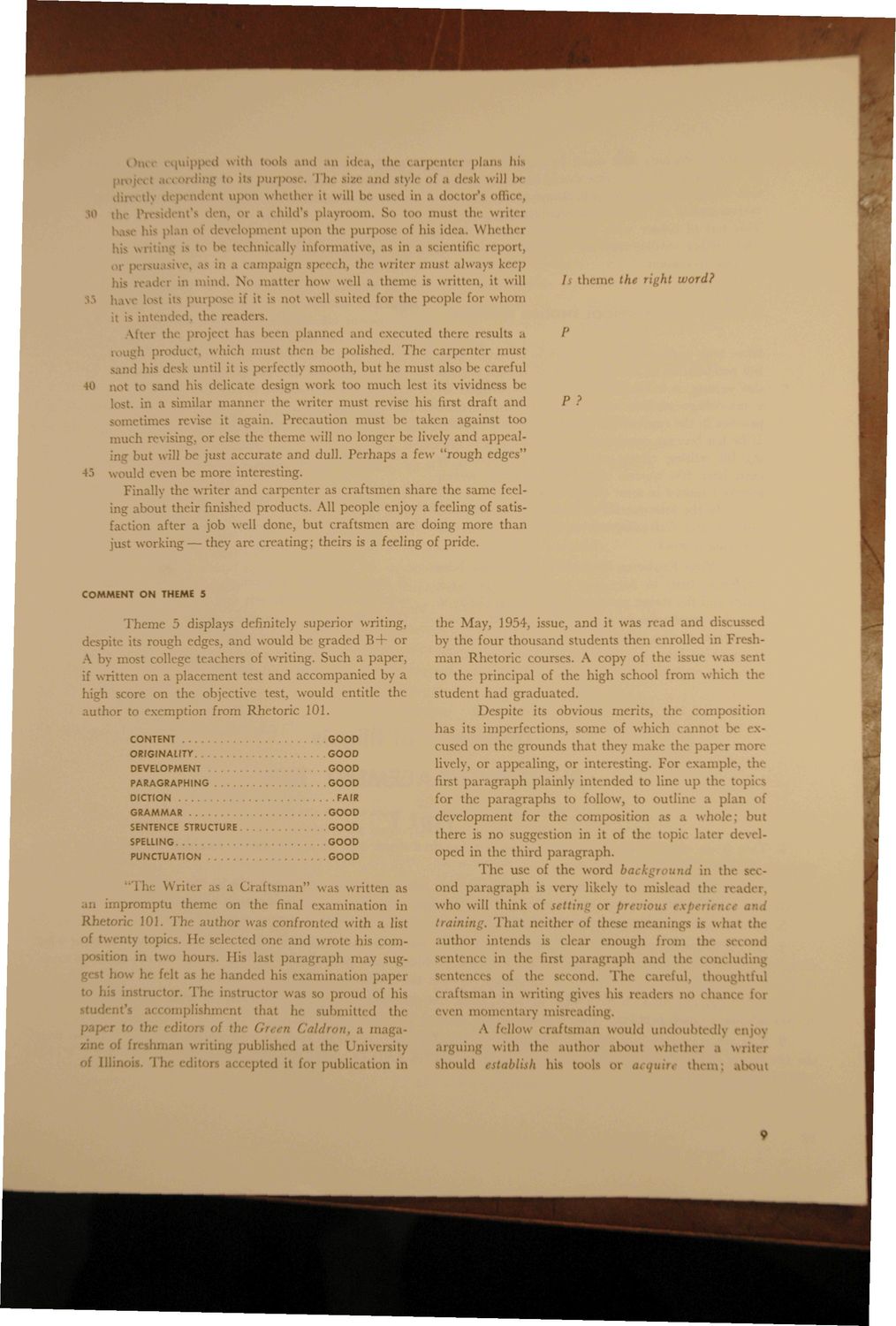| |
| |
Caption: Booklet - Standards in Freshman Rhetoric (1956)
This is a reduced-resolution page image for fast online browsing.

EXTRACTED TEXT FROM PAGE:
1 with tools and an idea, the carpcntci plana hii up The site and style oi a desk will be it upon whether it will be used in a doctor's offi< the r t\t*s den, hild*s playroom, So too must the writer n i levelopmcnt upon the purpose of his idea. Whether wj be technically informative, as in a scientific report, or ampaign speech, the writer must always keep h r in mind. N matter how well a theme is written, it will h a ve 1 up it" i: not well suited for the people lor whom nded, the readers. \ttv the project has been planned and executed there results a rough ] duct, which must then he polished. The carpenter must his desk until it is perfectl) aooth, hut he must also he careful 40 not to Sand his delicate design work too much lest its vividness be lost, in a similar manner the writer must revise his first draft and sometin :vise it ag i. Precaution must he taken against too much re\ r else the theme will no longer he lively and appealing but will be ju ite and dull. Perhaps a few "rough edges" 43 would even he more interesting. Finally the writer and carpenter as craftsmen share the same feelin ;bout their finished product \11 people enjoy a feeling of satisQ after a job well done, hut craftsmen arc doing more than ju working — they arc creating; theirs is a feeling of pride. v / theme the ri^ht word? P P ? COMMENT O N THEME 5 Thenn disp! s definitely superior writing, despite its rough ede . and would be graded R-f- or A by most coll t hers of writing. Such a paper, < if written on a placement test and accompanied by a high score on the objective test, would entitle the author to exemption from Rhetoric 101. CONTENT ORIGINALITY DEVELOPMENT PARAGRAPHING DICTION GRAMMAR SENTENCE STRUCTURE SPELLING PUNCTUATION GOOD GOOD GOOD GOOD FAIR GOOD GOOD GOOD GOOD "Th Writer . Cr. in" was written as i impromptu theme on tl final examination in Rhetoric 101. Th author was confronted with a 1! nt\ He sclei ind wrote his comu in t\ hours. His last par ph may su T - h< ided his examination paper *r. The instnn tor v. proud of his t's mplishi that he submitted the th' > the ( f n Caldron, a ma f fi i writing published at the University Mil ; 1 it for publication in the May, 1954, issue, and it was read and discussed by the four thou nd students then enrolled in I shman Rhetoric courses. A copy of the issue was sent to the principal of the high school from which th student had graduated. Despite its obvious merits, the composition has its imperfections, some of which cannot be i used on the grounds that they make the paper im lively, or appealing, or interesting. For - inple. the first paragraph plainly intended to line up the topic for the paragraphs to follow, to outline a plan ( development for the composition as a whole; hut there is no su tion in it of the topic later developed in the third paragraph. The use of the word /; ound in the second paragraph is very likely to mislead the reader, who will think of setting or pi ions e.v • train That neither of th meanings is what the author intends is clear enough from the secon sentence in the first paragraph ami the concluding ntences of tlu >nd. Tin- careful, thoughtful craftsman in writing gives his readers n< ham even momentary misreading. A fellow craftsman would undoubtedly en arguing with the author about whether a writ should tstablish his tools 01 them, about
| |